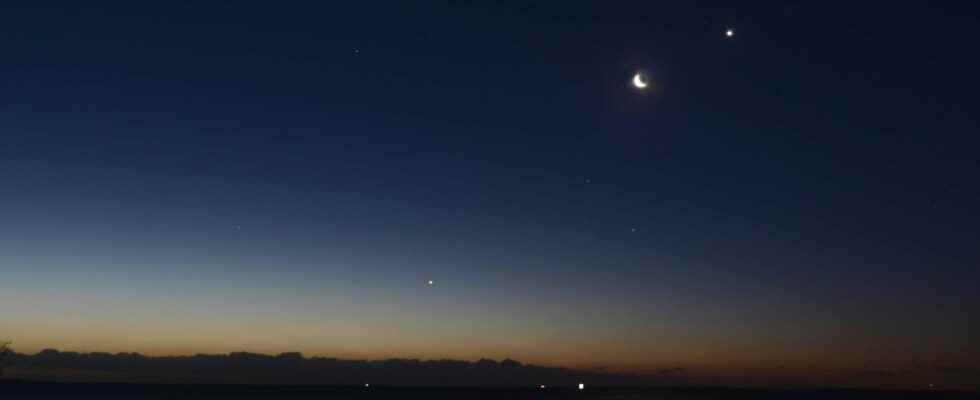The sky at dawn is populated by planets in the middle of the stars at the moment: no less than five aligned. Among them, two will get closer this weekend, until they almost stick together. But before this beautiful show, the Moon will compose a magnificent trio with them on May 25.
You will also be interested
[EN VIDÉO] A partial solar eclipse seen from Mars! On April 2, the Perseverance rover witnessed an eclipse of the Sun by Phobos, one of Mars’ two moons. It is the most detailed ever made since the Red Planet.
For several weeks you can see the morning to the east, southeast, before sunrise Sun, 5 planets aligned : Saturn, Neptune (this distant planet is not visible to theeye naked), Mars, Jupiter and the sparkling Venuslisted here in order from highest to lowest in the sky. Venuswho is therefore the last to stand up, and nicknamed the ” Evening Star is the brightest of all.
Moon, Jupiter and Mars: a very photogenic rapprochement
This Wednesday, May 25, after 4:30 a.m., you will be able to see the Moon crescent (25% of its illuminated disc) glow below the giant Jupiter and of March, our neighbor with the legendary red sparkle. The latter, closer to us than the first (but twice as small as the Earth) and much less bright in the sky than Jupiter (10 times larger than our planet). With the Moon, they form a very beautiful trio overhanging the horizon that many will not fail to capture in photo.
Very tight conjunction of Mars and Jupiter on May 29
These same two wandering stars (this is how the Greeks called the planets) which walk on theecliptic — currently in the Pisces — are approaching each other with great strides in the terrestrial sky. Separated by 2.5° on May 25, they continue their movements until Mars doubles Jupiter at the end of May. This Sunday, May 29 (that’s good!), at dawn, we will be able to admire them separated by only 0.6°.
A beautiful, very tight conjunction that it will be possible to see without difficulty with the naked eye. And in an instrument, Jupiter master of all the planets of the Solar system will appear significantly larger than its brother, in mythology, Mars. This will also suffer greatly from the turbulence very lively atmosphere which reigns this height in the sky (between 12 and 19° above the horizon), while it will be possible to discern the most important characteristics on Jupiter (cloud band, Galilean moons). The two stars will still be visible very close together on the mornings of May 30 and 31. Then, they will separate, Mars rising later and later after Jupiter. This is the last close encounter in the sky between two planets for several months.
To not miss any of the ephemeris of the month, discover our podcast Futura in the Stars, available on all the right platforms!
Interested in what you just read?
